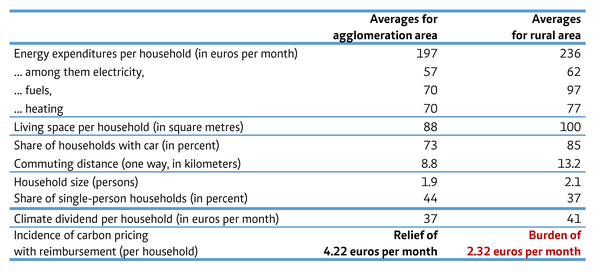Carbon pricing: differences between city and country
The difference in the average burden between urban and rural areas is small. In a sample calculation, it is 6 euros per month and household.
The monthly expenses for electricity, fuel and heating are almost 40 euros higher for an average household in rural areas than in agglomeration areas. This is due to the larger living space, increased car use and greater distances to the workplace (see table). Nevertheless, the burden of a carbon price with reimbursement is very low: as many more single households live in the city and more people live under one roof in the countryside, households in rural areas benefit more from per capita reimbursement. In addition, rural households benefit more from the electricity tax reduction because they consume more electricity. The bottom line is therefore that the burden in rural areas is only slightly higher: while a household in an agglomeration area gains an average of 4 euros per month with a carbon price of 130 euros in 2030, a rural household pays an extra 2 euros per month. More important than the differences between urban and rural areas are therefore targeted measures to avoid cases of hardship.
Table: Urban and rural average household
Calculation for a carbon price of 130 euros in 2030, revenue-neutral refund through electricity tax reduction and climate dividend of 233 euros per year and person. The values shown refer to an average household in an agglomeration area (regional centre with more than 100,000 inhabitants plus surrounding area with more than 200 inhabitants per square kilometre) and an average household in rural areas (no regional centre, less than 150 inhabitants per square kilometre). Data basis: EVS 2013 and IAB KB 10/2018 (commuting distance). Calculations based on Edenhofer et al. (2019): Options for a Carbon Pricing Reform.






